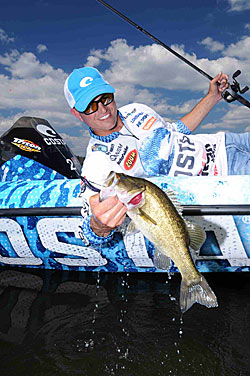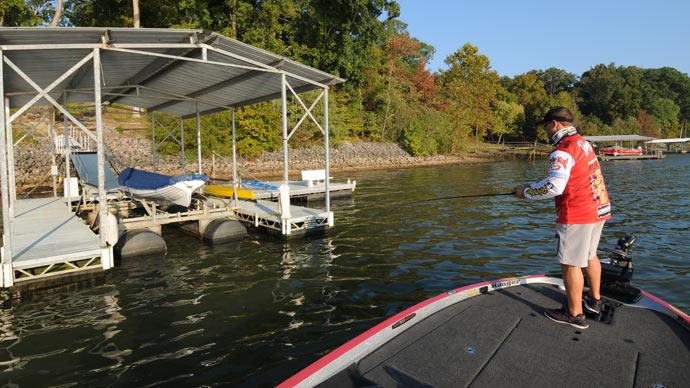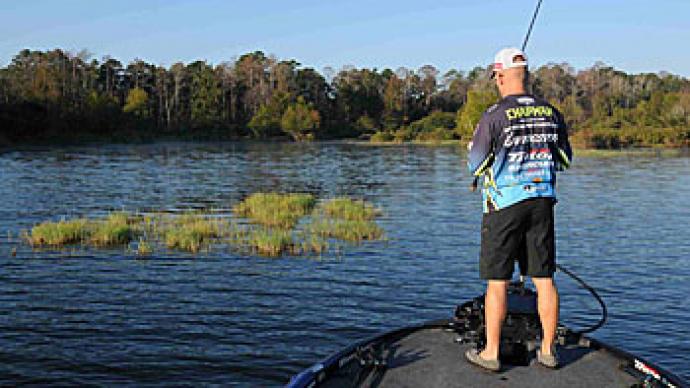
Successful anglers on the tournament trail are usually good matchmakers.
Count Casey Ashley among those successful pros who know how to match the right size and style hook with his lures to catch more bass. “Hooks are one of the most important things in fishing because if you have the right bait with the wrong hook in it, you are going to miss fish by not getting a good hookset,” Ashley said. “Picking the right hook for the right bait is a big thing. You can’t put a 3/0 hook in a Zoom Magnum Trick Worm because the worm is so thick that you won’t ever get a hookset. You may get bit, but you won’t get that fish in. “
Hook manufacturers offer a wide variety of hook sizes, styles, and metal gauges, thus confounding novice anglers in their efforts to match the right hook with their baits. Ashley discloses his hook selection process for the following styles and metal gauges.
Hook styles
The former Bassmaster Classic champion favors Gamakatsu hooks for most of his fishing applications. “They make a perfect offset round bend hook for Texas-rigging and trick worms,” he says. Ashley uses a wide range of sizes for the offset round bend hook ranging from 1/0 for finesse worms up to 6/0 for 12-inch plastic worms or Zoom Ol’ Monster worms.
The South Carolina pro prefers an Owner straight shank round bend hook for flipping Zoom Trick Worms or finesse worms on waters receiving heavy fishing pressure. He uses the straight shank hook for his floating worm tactics in open water. “You are going to get a better hook set with a straight shank than an offset any day,” Ashley says.
A Gamakatsu round bend worm hook is Ashley’s choice for working Zoom Flukes. He prefers a 5/0 model for throwing the Fluke around cover. “The hook is a little oversized, but it is big enough to keep the bait weedless, yet it will penetrate the bait easier,” he says. For fishing in open water, Ashley matches the Fluke with a 4/0 hook which he believes fits the lure better.
Ashley admits he is “not big” on wide gap hooks, but he will use extra wide gap (EWG) models for fishing Zoom Horny Toads. He believes 5/0 or 6/0 EWG hooks are best for Horny Toads because those models are the right fit for the toad. When rigged properly, the hook should run through the crease in the toad’s throat and exit between the lure’s legs, which can be skin-hooked over the toad’s back.

“You also want to use a super line hook (with the toad) because it is heavy gauge, and you are throwing that lure on braid,” Ashley said.
Ashley chooses weighted hooks during early spring for his Flukes to catch suspended bass. While some anglers prefer rigging Flukes on a jighead, Ashley opts for a hook with the weight on the hook's shaft to give the fish a different look. “That weighted hook has a lot slower rate of fall, and it falls differently (than the jighead and Fluke combo),” he said. “The Fluke kind of glides instead of going head down.”
Before he fishes hard plastic lures such as crankbaits, stickbaits, and topwater plugs, Ashley frequently changes the treble hooks over the factory-installed trebles. “I always like to go one (hook) size bigger, but some baits don’t allow you to do that,” he says.
His favorite replacement trebles for crankbaits are the Mustad Kevin VanDam Elite Triple Grip Treble Hooks. “It’s a short hook, and it’s strong,” Ashley says. “It’s a heavy gauge hook but not too heavy.”
For topwater baits, Ashley usually upgrades his treble hooks to one or two sizes bigger than the lure’s original trebles. Ashley also changes the front hook to a red treble because he believes bass hone in on the red hook and hit the front of the lure, giving him a better chance for a hookup.
The four-time B.A.S.S. winner favors Gamakatsu round bend treble hooks for his topwater poppers and replaces the back treble with a feathered hook. Since he frequently fishes walking topwater baits on braided line, Ashley switches the lure’s original trebles with Eagle Claw treble hooks, which he thinks has a good barb he likens to a fish gaff. Ashley claims his catch rate increases to about 90 percent when he uses braided line and the Eagle Claw trebles for his walking surface plugs.
Metal gauges
The tactic and type of line he is using determines whether Ashley uses a light wire gauge or heavy wire gauge hook. He relies on light wire hooks such as 1/0 offset worm hooks for throwing soft plastics on light fluorocarbon line. Ashley also favors 4/0 or 5/0 light wire Gamakatsu Finesse Heavy Cover Hooks for making long-distance pitches on 15-pound fluorocarbon with Texas-rigged magnum-size plastic worms. He believes the lighter wire hook provides a better hook set than a heavier gauge hook when the bait is farther away from him.
A heavier gauge flipping hook is needed for pitching soft plastics into thick bushes or any other heavy cover at close range. Ashley also recommends using heavy gauge “super line” hooks when flipping or pitching with braid.
BassResource may receive a portion of revenues if you make a purchase using a link above.




